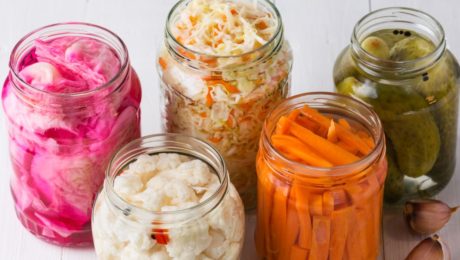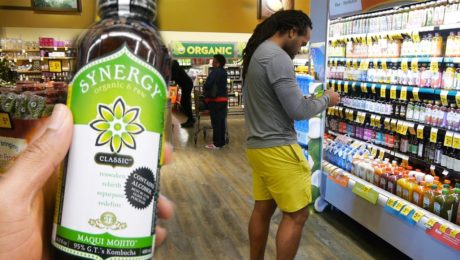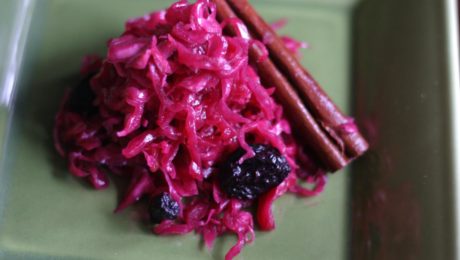Harnessing the Power of the Microbiome
A team of nearly three dozen researchers from around the world reviewed case studies on microbiome research in agrifood systems. Their results, published in the journal Frontiers in Microbiology, “showcase the importance of microbiome research in advancing the agrifood system.”
Their 14 success stories include a broad range of topics within agrifood:
- Microbial dynamics in food fermentation
- Using microorganisms as soil fertilizers
- Applications to improve HACCP systems
- Identification of novel probiotics and prebiotics to prevent disease
- Using microbiomes of fermented foods for starter cultures
- Fermenting feed to improve the microbiomes of livestock
- Identifying microbes in fermented meats
- Using microbiota analysis for fermented dairy products
To further microbiome use in food systems, the research points to studies highlighting that fermented foods include many health-promoting metabolites (including studies by TFA Science Advisory Board member Maria Marco, a University of California, Davis, food science professor). But, the researchers stressed: “How certain microorganisms drive food fermentation, are transferred across the food production chain, persist in the final product and, potentially, colonize the human gut is poorly understood.” Researchers conclude that more work is needed to understand how the probiotics and metabolites in fermented foods could be used to treat diseases.
“Agrifood companies recognize the potential in understanding the microbiome and translating this knowledge into products,” the study continues. The food industry, the study notes, is “further preparing to develop personalized diets and specific foods for particular target groups in order to prevent or treat certain chronic conditions.”
“The microbiomes of soil, plants and animals are pivotal for ensuring human and environmental health. Research and innovation on microbiomes in the agrifood system are constantly advancing, and a better understanding of these microbiomes will be a key factor in producing highly nutritious, affordable, safe and sustainable food.”
Read more (Frontiers in Microbiology)
Infants Sleep More if Mom Eats Fermented Foods
Toddlers and infants slept 10 hours or more a night if their mother ate fermented foods while pregnant, according to a new Japanese study.
The results, published in the journal BMC Public Health, studied over 64,000 pairs of mothers and their children. The diet of pregnant mothers was found to have an impact on sleep length of their children. Pregnant women who consumed miso, yogurt, cheese and/or natto all had children that slept 10+ hours a night until the age of 3. The article calls it “fermentation for hibernation.”
The study notes, though, that there are other associated factors at play. The women consuming fermented foods were well-educated, employed and had higher incomes compared to the pregnant mothers not regularly consuming fermented foods. Scientists inferred that this higher demographic group “likely recognized factors that could contribute to health and chose nutrient-rich options [instead of] nutritionally-unbalanced food.”
Read more (NutraIngredients)
Chicago: A Fermentation Hub
If you still think of hot dogs and deep dish pizza as the icons of Chicago’s culinary scene, you need to think again. The so-called Capital of the Midwest is a hub of innovation in the food industry. Chicago has the largest food and beverage production in the U.S., with an annual output of $9.4 billion. Food startup companies in the region raised $723 million in venture capital last year.
“Chicago is one of the most diverse cities for eating,” says Anna Desai, Chicago-based influencer of Would You Like Something to Eat on Instagram. ”Our culinary scene is constantly elevating and evolving. We are always just a neighborhood or tollway away from experiencing a new culture and cuisine. I’m most excited when I find an under-the-radar spot or discover a maker who can pair flavors and ingredients that get you curious and wanting more.”
Desai started her blog in part because she wanted to champion the Asian American and Pacific Islanders (AAPI) community in the Chicago food and beverage scene. “Food has long served as a cultural crossroad,” she adds, and Chicago’s multicultural cuisine exemplifies that sentiment.
Chicago is home to some of the most creative minds in fermentation, from celebrity chefs, zero waste ventures, alternative protein corporations and the world’s largest commercial kefir producer. There are dozens of regional and artisanal producers lacto-fermenting vegetables, brewing kombucha and experimenting with microbes in food and drink.
“Chicago is a great food city in its own right, so naturally there is a ton of talent in the fermentation space,” says Sam Smithson, chef and culinary director of CultureBox, a Chicago-based fermentation subscription box. “The pandemic’s effect on restaurants has also spawned a new wave of fermenters (ourselves included) that are looking for a path outside the grueling and uncertain restaurant structure to display our creative efforts. This new wave is undoubtedly community-motivated and concerned more with mutual aid than competition. There is a general feeling that we are all working towards the same goal so cooperation and collaboration is soaring and we are seeing incredible food come from that.”
Flavor is King
Flavor development is still the prime motivation for chefs to experiment with fermentation. A good example is at Heritage Restaurant and Caviar Bar in Chicago’s Humboldt Park neighborhood.
“Fermentation has been a cornerstone of the restaurant since its inception,” says Tiffany Meikle, co-owner of Heritage with her husband, Guy. “With the diverse cuisines we pull from, both from Eastern and Central Europe and East Asia, we researched fermentation methodologies and histories, and started to ‘connect the dots’ of each culture’s fermentation and pickling backgrounds.”
Menus have included sourdough dark Russian rye bread, toasted caraway sauerkraut, kimchi made from apples, Korean pears and beets and a kimchi using pickled ramps (wild onions). Heritage has also expanded their fermentation program to the bar, where they’ve created homemade kombucha, roasted pineapple tepache, sweet pickled fruits for cocktail garnishes, and kimchi-infused bloody mary mix.
“It’s fascinating to me that there are so many ingredients you can use in a fermented product,” says Claire Ridge, co-founder of Luna Bay Booch, a Chicago-based alcoholic kombucha producer. “People are really experimenting with interesting ingredients in kombucha…I have seen brewers do some of the wildest recipes and some recipes that are very basic.”
Innovating Food
Chicago-based Lifeway Kefir is indicative of the innovation taking place in the city. Last year the company expanded into a new space: oat-based fermentation, launching a dairy-free, cultured oat milk with live and active probiotics.
“We’ve spent so many years laying the groundwork in fermented dairy,” says Julie Smolyansky, CEO. “Now we’re experimenting and expanding to see what’s over the next horizon, though we’ll always have kefir as our first love.”
Chicago is home for two inventive fermented alternative protein startups: Nature’s Fynd and Hyfé Foods. Both companies were born out of the desire to create alt foods without damaging the environmental.
“Conscious consumerism is a trend that’s driving many people to try alternative proteins, and it’s not hard to understand why,” says Debbie Yaver, chief scientific officer at Nature’s Fynd. The company uses fermentation technology to grow Fy, a nutritional fungi protein. “Fungi as a source of protein offer a shortcut through the food chain because they don’t require the acres of land or water needed to support plant growth or animal grazing, making fungi-based protein more efficient to produce than other options.”
Alternative foods outlasting the typical trend cycle is a challenge for companies like Nature’s Fynd. When grown at scale, Fy uses 99% less land, 99% less water and emits 94% fewer greenhouse gasses than raising beef. But, to make an impact, “we need more than just vegans and vegetarians to make changes in their diets,” Yaver adds.
Waste Not
Numerous companies are using fermentation as a means to eliminate waste. Hyfé Foods, another player in the alternative protein space, repurposes sugar water from food production to create a low-carb, protein-rich flour. Fermentation turns a waste product into mycelium flour, mycelium being the root network – or hyphae (hence the company name) — of mushrooms.
“[We’re] diverting input to the landfill and reducing greenhouse gas emissions at scale,” says Michelle Ruiz, founder. “Hyfé operates at the intersection of climate and health, enabling regional production of low cost, alternative protein that reduces carbon emissions and is decoupled from agriculture.”
Symmetry Wood is another Chicago upcycler. They convert SCOBY from kombucha into a material, Pyrus, that resembles exotic wood. Founder Gabe Tavas says Pyrus has been used to produce guitar picks, jewelry and veneers. Symmetry uses the discarded SCOBY from local kombucha brand Kombuchade.
Many area restaurants and culinary brands also use fermentation to preserve food for the long Chicago winters, when local produce isn’t available. Pop-up restaurant Andare, for example, incorporates fermentation into classic Italian dishes.
“Finding ways to utilize what would otherwise be waste products inspired our initial dive into fermentation. The goal is not just to use what’s leftover, but to make it into something delicious and unique,” says Mo Scariano, Andare’s CEO. “One of our first dishes employing koji fermentation was a summer squash stuffed cappellacci served with a butter sauce made from carrot juice fermented with arborio rice koji. Living in a place with a short grow season, preservation through fermentation allowed us access throughout the year to ingredients we only have fresh for a few weeks during the summer.”
Industry Challenges
Despite growing interest and increasing sales, fermenters face some significant hurdles.
Smithson at CultureBox says he sees that consumers are open to unorthodox, less traditional ferments. Though favorites like kombucha and sauerkraut dominate the market, “their share is being encroached on by increasingly more varied and niche ferments.” But getting these products to market can be a challenge. Small-scale, culinary producers are challenged by the regulatory hoops they need to jump through to legally sell ferments – especially unusual ones a food inspector doesn’t recognize.
“The added layer of city regulations on top of state requirements, sluggish health department responses, and inflexible policy chill the potential of small producers,” Smithson says. But he highlights the recently-passed Home-to-Market Act of Illinois as positive legislation helping startup fermenters.
Consumer awareness and education are also vital. “Many longstanding and harmful misconceptions on the safety and value of fermented products still exist,” Smithson says.
Matt Lancor, founder and CEO of Kombuchade makes consumer education a core part of marketing, to align kombucha as a recovery drink.
“Most mainstream kombuchas are marketed towards the yoga/crystal/candle crowd, and I saw a major opportunity to create and market a product for the mainstream athletic community,” he says. “We’re on a mission to educate athletes and the general public about these newly discovered organs [the gut] – our second brain – and fuel the next generation of American athletes with thirst quenching, probiotic rich beverages.”
Product packaging provides much of a consumer’s education. Jack Joseph, founder and CEO of Komunity Kombucha, says simplicity is key.
“People are more conscious of their health now, more than ever before,” he says. “So now it comes down to the education of the product and creating something that is transparent and easy for the consumer to digest.”
Sebastian Vargo of Chicago-based Vargo Brother Ferments agrees.
“Oftentimes food is considered ‘safe’ due to lack of microbes and how sterile it is,” he says. “Fermentation eschews the traditional sense of what makes food ‘safe’. We need to create a set standardized guide for fermented food to follow, and change our view of living foods in general. One of the brightest spots to me is the fact that fermentation is really hitting its stride and finding its place in the modern world, and I don’t see it going anywhere but up in the near future.”
- Published in Business, Food & Flavor
Beauty Embraces Bacteria
Beauty brands continue to capitalize on a trend: putting prebiotics, probiotics and postbiotics into skin-care products. This “wave of new products” that tout -biotics is filling the cosmetic aisle, according to The New York Times.
“It’s like ‘Star Wars’ happening on the surface of skin,” says Dahlia Devkota, founder of the Los Angeles-based skin-care brand Editrix. “‘Good’ and ‘bad’ bacteria both excrete postbiotics, which are their weapons of war. The goal is a balance of both with no one species taking over.”
Devkota adds that she finds skin care products with -biotics are gentler on the skin. Many traditional skin-care brands strip the skin of natural oils, “weaken(ing) the skin barrier.”
Some brands are experimenting with using fermented ingredients in their skin care products. Venn, another Los Angeles-based skin-care brand, has a scientific advisory board that has spent decades studying the microbiome. Venn’s Synbiotic Defense Mist face spray uses water with probiotic ferments.
“Because fermentation makes the molecules smaller, the product can penetrate the skin surface more deeply,” says Jeff Rosevear, the head of skin-care research and development for new brands at Unilever. The company’s new line, Ferver, has a serum made with fermented collagen.
Read more (The New York Times)
Fermented Foods and Running
Fermented foods continue to top nutritionists’ lists as a key healthy and functional component in the ideal human diet. In a new article in Runner’s World, a registered dietician recommends runners eat fermented foods to meet nutrition needs, improve their health and better support their training.
The author lists four reasons to eat fermented foods: improve the gut microbiome, add a nutritional upgrade, aid digestion and improve protein intake.
“Recent research even suggests that the makeup of our microbiome may also play a role in how our muscles adapt and develop in response to exercise. And fertilizing your gut with more desirable bacteria via fermented foods may payoff with better digestive functioning during periods of hard training and throughout long races (read: fewer sprints to the nearest port-a-potty),” the article reads. “To date, the literature suggests that probiotic foods (like fermented foods) are still the preferred method of obtaining probiotics rather than relying on supplements.”
Read more (Runner’s World)
- Published in Health
Marketing Gut Health
Consumers want foods that aid gut health, but brands face a major challenge. How can they educate buyers about microbiome health benefits without getting into trouble with regulators?
“It’s no longer enough to just say ‘healthy,’” says Alon Chen, CEO and co-founder of Tastewise, an “AI platform for food brands.” “We are absolutely more critical of health claims in general. We want to know how, we want to know why and we want it backed by science.”
The term “healthy” is no longer resonating with consumers. Over 30% are looking for products with multifunctional benefits, according to research by Tastewise. They want more detail, on topics such as gut health, sleep improvement, brain function, anti-bloating and energy.
“Food is no longer just about nutrition, nor is it about general health,” says Flora Southey, editor at Food Navigator. “Consumers want more from the food they consume – and they want to be specific about it.”
What are the challenges and opportunities for brands trying to deliver gut health? A panel of food and nutrition experts tackled the issue during a Food Navigator webinar: “From Fermentation to Fortification: How is Industry Supporting Gut Health and Immunity?” Here are highlights.
Regulation Woes
There are trillions of microbes in our gut, but science has only scratched the surface of their power. Gut health is an ambiguous – and often confusing – subject for consumers.
Regulations on gut health claims are evolving. A year ago, the European Food Standard Authority asked food producers to help evaluate microbiome-based product claims.
“In order for us to assert ourselves in the industry, we have to be able to defend and support these claims,” says Anthony Finbow, CEO of Eagle Genomics, a software company incorporating microbiome research into their data analysis.
It’s “the dawn of a new age,” according to Finbow. Major food companies are now valued for delivering nutrition in addition to caloric content. “There is greater consumer understanding that food is a mechanism for better health.”
Southey feels brands need to do more for consumer education “I’m not convinced [the message is] getting to the consumer as well as it should be.”
Nutrition drink brand MOJU is attempting to tackle the regulatory stumbling block of health benefits on a label. Strict rules requiring detailed substantiation have resulted in few gut health claims“We’ve got a long way to go from an education point of view,” says Ross Austen, research and nutrition lead at MOJU.
MOJU can’t use the term “gut health,” but they can say a drink contains vitamin C or D, which have been proven to boost the immune system. They can’t say their drink is anti-inflammatory, but they can say it contains turmeric, known for its anti-inflammatory properties.
Marketing -Biotics
More consumers want the presumed gut health benefits of probiotics, prebiotics and postbiotics to power their microbiome. Probiotics “have largely stolen the headlines over the past few years,” Austen says, but prebiotics are appearing in more and more products. MOJU puts prebiotic fiber in their drinks because probiotics are a challenge for packaged food products. Because probiotics contain live and active cultures, they must be refrigerated and their efficacy tested.
Ashok Dubey, Phd, senior scientist and lead for nutrition sciences at TATA Chemicals (a supplier of chemical ingredients to food and drink producers), agrees. Dubey feels that the benefits of probiotics have been diminished in the minds of consumers. He notes that when probiotics first began appearing in foods 20 years ago, they were claimed to be able to solve any and all health ailments.
“There’s a greater understanding that our gut microbiota is so complex, if the food we eat is so complex, then the solution we should provide should be a combination of all of this,” he says. Dubey is seeing more patents combining probiotics and prebiotics, a complex solution that he says looks at whole health.
But, he notes, any claim with -biotics must be validated by scientific research.
Traditional Foods vs. Clinical Trials
Hannah Crum, president of Kombucha Brewers International (KBI), takes issue with the need to validate every health claim with scientific research. “We shouldn’t displace a huge body of traditional knowledge in favor of pharmaceuticals,” she says.
Making health claims around -biotics has been challenging for the kombucha industry. “It doesn’t honor what food does for us nutritionally,” she adds. Today’s food industry is so heavily regulated that foods traditionally consumed by humans for centuries – like kombucha – can’t put a health claim on a label without proving benefits in a human clincal trial.
“It’s frustrating,” Crum says. ““In fact, because there is no definition of the word probiotic from a legal perspective, it leaves our brands vulnerable to be attacked by parasitic lawyers who just want to extract value from large corporations because they can.”
“In my opinion, we need to honor the fact that all traditionally fermented foods are probiotic by nature instead of saying ‘Well you need the research to prove it,’” she says.
Are -Biotics Becoming a Diluted Claim?
More and more food and beverages are labeling their product with -biotics – probiotics, prebiotics and postbiotics — confusing consumers as to what a -biotic is and its potential health benefit.
There’s an “overuse of the term probiotic as referring to any live microbe,” says Bob Hutkins, professor of food microbiology and the University of Nebraska (and a Science Advisor on TFA’s Advisory Board). Probiotics, according to the International Scientific Association of Probiotics and Prebiotics (ISAPP), require documentation of both a health benefit and the strain.
“It’s a high bar to call something a probiotic,” he continues. “I read labels that say ‘contains probiotics’ and I’d say, the vast majority of the time, they’re incorrectly named if they’re named at all.”
Hutkins was part of a panel hosted by Food Navigator on “Feeding the Gut Microbiome: From Pre-, Pro-, and Postbiotics.” Speakers included leaders of food brands and -biotic supplement brands.
Is a Fermented Food Probiotic?
The issues surrounding probiotics and fermented foods have long been debated. TFA hosted a webinar on the topic in 2021, and it was the focus of a keynote session at TFA’s FERMENTATION 2021 conference.
Using the example of kimchi, Hutkins explains the fermented cabbage may contain live microbes that closely resemble a probiotic strain. But, according to scientific-backed definitions by ISAPP and the World Health Organization (WHO), “you can’t call that kimchi probiotic unless you isolated the strain, characterized the strain, done a clinical study and then that kimchi is going to be different from the kimchi you’ll make tomorrow. So it’s a challenge for companies that are producing fermented foods that probably have live microbes that can provide some benefits, but you can’t call them probiotics.”
Hutkins encourages fermentation producers to use the term “rich in live microbes” on their label instead. If the product does include clinically tested probiotics (like in yogurt), “I really applaud the company that puts the genus and species on their package.”
Consumer Education
Miguel Freitas, PhD, vice president of health scientific affairs at Danone North America, says the conversation in the industry needs to change from just probiotics to strain specificity.
“There are many consumers that are just seeking the word probiotic on the packaging. And they believe that probiotics will [help] everything from immune health to gut health,” Freitas says. “This is where I believe it can start to get tricky because there are so many products out there.”
Though the science around -biotics has evolved tremendously in the past two decades, consumers are overwhelmed and confused by all the choices.For example, he points to a new clothing brand that alleges the probiotics in their clothes are activated by heat.
This is why the food and beverage industry needs to play an active role in consumer education, says Todd Beckman, president of Verb Biotics.
“They have a platform to talk about health, these specific ingredients and health benefits,” he says. “They have the megaphone to talk to consumers in a true and authentic way.”
But Beckman warns: “the brands that don’t really know what they’re doing or don’t stand for anything or don’t stand for science, they’re not going to be there tomorrow.” Consumers will abandon brands with unsubstantiated health claims.
“If all of a sudden consumers aren’t believing in probiotics or what they can do, then it’s quite damaging,” he says.
Tom First, founder and CEO of Culture Pop probiotic soda, says that, though their brand has the clinical benefits of a verified and shelf-stable probiotic strain, they don’t lead with this complicated information in their marketing. Instead, they focus on flavor and it “being a fun drink,” figuring consumers can look to the Culture Pop website if they want to dive deeper.
Assorted -Biotics
Adding to consumer confusion: products on grocery shelves may now contain one of three -biotics – probiotics, prebiotics or postbiotics. Justin Green, PhD, director of scientific affairs at Cargill Health Technologies, says many think of -biotics as a daily supplement with a simple health benefit, like vitamin C.
“We really have to drive home there’s going to be different [-biotics] from different organisms, different fermentation techniques and most importantly different health benefits,” he says.
Probiotics are live bacteria; prebiotics are food for the bacteria; and postbiotics are metabolites produced by the probiotics.
Kombucha Sales Crawl
Two years after kombucha sales began to clock double-digit growth during the pandemic, sales are slowing, increasing only 1% over the last 52 weeks. But kombucha is still the sales leader in the fermented, non-alcoholic beverage space, representing nearly 85% of the category.
Kombucha pioneered the refrigerated functional beverage industry. For years it was one of the few beverages in the fermented, non-alcohol beverage space. But now there’s competition from new functional drinks — like prebiotic- and probiotic-infused sodas — that are diverting sales from kombucha.
“The consumer really is not OK with just drinking water. They want functionality out of everything they consume,” says Caroline Davidson, director of channel partnerships at SPINS (a data provider for natural, organic and specialty products). “Non-alcoholic beverages are traditionally not healthy options. To see that kombucha is actually one of the few segments contributing to double-digit growth (in that category), it’s really refreshing and encouraging.”
Those numbers were presented at KombuchaKon, the conference and trade show produced by Kombucha Brewers International (KBI). The event had been virtual the last two years, and brewers were anxious to meet in person again. Hundreds of brewers and brand leaders converged last week in Long Beach, Calif.
Here are highlights from SPINS’s kombucha market analysis.
Functional Beverages Grow
Refrigerated functional beverages are a top growth category across all sales channels — natural products stores, regional groceries and multi-outlet retailers (MULO) like WalMart, Target and CVS. Beverages made with -biotic cultures, high fiber sodas, water kefir sodas, drinking vinegars, kvass and tepache are all part of that growing category — and they compete with kombucha.
Shelf-stable functional beverages are growing even more quickly. For example, in the natural channel, sales of these drinks have increased nearly 25%, versus 4% for their refrigerated counterparts.
“It may not be refrigerated, but it still may be competition to a kombucha,” Davidson says.
Major Brands Diversify
Kombucha-adjacent products — like powdered kombucha and kombucha-flavored yogurt bites — are entering the market. So are kombuchas with no sugar or less than 1 gram of sugar.
“I am consistently seeing no sugar options in fermented beverages, which I know I’m speaking to an audience that already knows this, but fermentation doesn’t happen without sugar,” Davidson says. She notes more and more beverage categories “are seeing differentiation within probiotics of fermentation.”
Of the five fastest growing kombucha brands,— only two – Wild Tonic and Better Booch – are selling just traditional kombucha or hard kombucha. The other three – Humm, Health-Ade and Rowdy Mermaid – have added new product lines. Humm and Health-Ade sell prebiotic sodas and Rowdy Mermaid offers tonics.
Health-Ade is marketing their brand as a “gut health beverage” instead of simply kombucha. In a statement, Health-Ade CEO and co-founder Diana Trout says: “We have seen a dramatic increase in consumer interest in gut health over the past year as people begin to realize just how important gut health is to immunity and overall health. We wanted to offer our customers something that doesn’t compromise on taste and has legitimate gut health benefits, and (our new prebiotic drink) Pop does just that.”
Defining the Product
KBI has been well aware of changes in the category. Two years ago, it released the kombucha Code of Practice, the first set of safety and quality standards for the industry.
“Kombucha” is not a protected product name, unlike “tequila” or “champagne.” With the code, KBI aims to protect kombucha as a traditional fermented beverage. But KBI also doesn’t want to eliminate kombucha brands that may pasteurize and sell in shelf-stable cans, process from a base or brew with sweeteners.
Joshua Rood, CEO and managing director of Dr Hops hard kombucha, attended the SPINS presentation and thinks KBI “is standing in the right place.”
“First, we have to define what kombucha is. And then how you label variations of that, like if it’s filtered or pasteurized. Then you can actually have clarity and transparency for consumers so they actually know what they’re getting,” Rood says. “Right now, we don’t have that. It’s very rough, it’s essentially just an honor system.”
Rood emphasizes he has no problem with kombucha brands not brewing with traditional methods. But he says there needs to be a classification system and transparent labeling of how a kombucha is made. “There’s a lot of room for education,” he says.
Dr Hops, for example, prints a nutrition fact panel and calorie listing on their hard kombucha, even though most beer, wine and spirits are not legally required to do so.
“We try to be massively over-communicative on our labels,” Rood says. “And, if you’re looking at our labels from a calorie stance, it doesn’t look good because we have such high alcohol content. We’re not competitive in calories. But if we put it on there, people will learn that it’s 10% alcohol and most of the calories come from the alcohol.”
Shift in Retail Channels
Sales in natural stores – the retail channel that helped launch the kombucha industry have slowed, actually declining 5% over the past year. . But sales over the same period grew 3% in MULO outlets and 2% at convenience stores.
“People are still trying to find outlets where they can get everything in one trip,” Davidson says. “We’re seeing a lot more consolidation of what people are purchasing in one trip or fewer trips per month.”
Hard Kombucha “Massively Outperforming”
SPINS’s “flavored malt beverages” category includes a number of alcoholic drinks that don’t contain malt. While hard seltzers have long dominated here, six of the 10 fastest-growing brands in natural retailers are now hard kombucha brands: Boochcraft, Flying Embers, June Shine, Kyla, Strange Beast and Nova Easy.
“Natural retailers are fully embracing this as a new category and it’s paying off exponentially,” Davidson says.
Hard kombucha sales are still small overall, at $58.31 million, are driving growth in the category and “massively outperforming hard cider,” Davidson says. Dollar growth for hard kombucha is almost 60%, while sales of hard cider are declining. Sales for the hard seltzer – including category leaders White Claw and Truly – are also slipping in all retail channels.
- Published in Business
“Bacterial Bully” Could Create Healthier & Tastier Fermented Foods
Microbiologists have long considered that there are two distinct categories of energy conservation in microorganisms: fermentation and respiration. Lactic acid bacteria (LAB) use fermentation, making it central to food and drink production and preservation since the dawn of man.
But researchers at the University of California, Davis, and Rice University discovered a LAB species that uses a hybrid metabolism, combining both fermentation and respiration.
“These are two very different things, to the extent that we classify bacteria as basically one or the other,” said Caroline Ajo-Franklin, a bioscientist at Rice University and co-author of the study. “There are examples of bacteria that can do both, but that’s like saying I can ride a bicycle or I can drive a car. You never do both at the same time.”
“What we discovered is a LAB that blends the two, like an organism that’s not warm- or cold-blooded but has features of both,” she said. “That’s the big surprise, because we didn’t know it was possible for an organism to blend these two distinct metabolisms.”
The species — lactiplantibacillus plantarum — is what scientists call a bacterial bully because it takes advantage of two distinct metabolic processes, according to a press release from Rice on the study. These systems were “not previously known to coexist to acquire the fuel they burn for energy.”
“Using this blended metabolism, lactic acid bacteria like L. plantarum grow better and do a faster job acidifying its environment,” said Maria Marco, a professor in the food science and technology department at UC Davis and the study’s co-author [and a TFA Science Advisor].
The discovery is significant for food and chemical production. New technologies that use LAB could now produce healthier and tastier ferments, minimize food waste and change the flavors and textures of fermented food.
“We may also find that this blended metabolism has benefits in other habitats, such as the digestive tract,” Marco said. “The ability to manipulate it could improve gut health.”
The study began with a puzzle: the realization that genes responsible for the electron transfer pathway in mainly respiratory organisms also appear in the LAB genome. “It was like finding the metabolic genes for a snake in a whale,” Ajo-Franklin said. “It didn’t make a lot of sense, and we thought, ‘We’ve got to figure this out.’”
While the Davis lab studied the genome, the team at Rice carried out fermentation experiments on kale.
“It wasn’t our first choice,” said Rice alumna and co-lead author Sara Tejedor-Sanz (now a senior scientific engineer in the Advanced Biofuels and Bioproducts Process Development Unit at Lawrence Berkeley National Lab).
“We performed some initial experiments with cabbage, since that’s a known fermented food — sauerkraut and kimchi — in which lactic acid bacteria are present,” she said. “But there were technical difficulties and it didn’t turn out so well. So we looked for another food to ferment where LAB could be found in its ecological niches.
“Kale has compounds like vitamins and quinones that lactic acid bacteria use as cofactors in their metabolism, and are also involved in interacting with the electrodes,” she said. “We also found fermenting kale to make juice was a trend. It sounded perfect for our biochemical reactors.”
The study showed LAB enhances metabolism through a FLavin-based Extracellular Electron Transfer (FLEET) pathway that expresses two genes (ndh-2 and pp1A) associated with iron reduction, a step in the process of stripping and incorporating electrons into ATP (adenosine triphosphate (ATP), energy-carrying molecule).
Because LAB’s genome has evolved to be small, thus requiring less energy to maintain, the wide conservation of FLEET must serve a purpose, Ajo-Franklin said.
“Our hypothesis is this helps bacteria get established in new environments,” she said. “It’s a way to kick-start their metabolisms and outcompete their neighbors by changing the environment to be more acidic. It’s being a bully.”
That the FLEET pathway can be triggered with electrodes offers many possibilities, she said. “We found we can use the hybrid metabolism in food fermentation,” Ajo-Franklin said. “Now we have a way to change how food may taste and avoid failed food fermentations by using electronics.”
“We may also find that this blended metabolism has benefits in other habitats, such as the digestive tract,” Marco said. “The ability to manipulate it could improve gut health.”
Ajo-Franklin noted LAB are commonly found in the microbiomes of many organisms, including humans. “You can already buy it in health food stores as a probiotic,” she said. “The human gut is an anaerobic environment, so LAB have to keep a redox balance. If it oxidizes carbon to gain energy, it has to figure out a way to reduce carbon somewhere else.
“Now we think if we provide another electron donor or acceptor, we could promote the growth of positive bacteria over negative bacteria.”
UC Davis graduate student Eric Stevens is co-lead author of the study. Co-authors are Rice graduate student Siliang Li; at UC Davis, graduate students Peter Finnegan and James Nelson, and Andre Knoesen, a professor of electrical and computer engineering, at UC Davis; and Samuel Light, the Neubauer Family Assistant Professor of Microbiology at the University of Chicago.
Ajo-Franklin is a professor of biosciences and a CPRIT Scholar. Marco is a professor of food science and technology.
The National Science Foundation, Office of Naval Research, the Department of Energy Office of Basic Energy Sciences and a Rodgers University fellowship supported the research.
The study results were published in the journal eLife.
- Published in Food & Flavor, Health, Science










